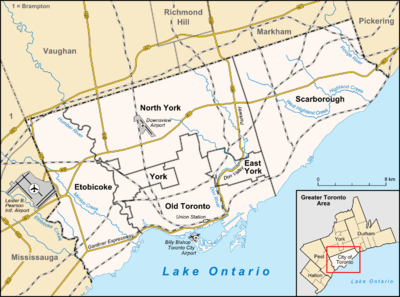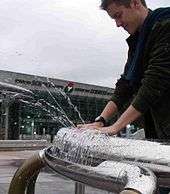Ontario Science Centre
 | |
 Location of the Ontario Science Centre in Toronto | |
| Former name | Centennial Science Centre |
|---|---|
| Established | September 26, 1969 |
| Location |
770 Don Mills Road Toronto, Ontario, Canada M3C 1T3 |
| Coordinates | 43°43′00″N 79°20′18″W / 43.71667°N 79.33833°W |
| Type | Science center |
| Accreditation | Association of Science-Technology Centers (ASTC) |
| Director |
Maurice Bitran, CEO Brian Chu, Chair |
| Owner | Government of Ontario |
| Public transit access |
|
| Website | http://www.ontariosciencecentre.ca/ |

.jpg)
Ontario Science Centre (French: Centre des sciences de l'Ontario) is a science museum in Toronto, Ontario, Canada, near the Don Valley Parkway about 11 kilometres (6.8 mi) northeast of downtown on Don Mills Road just south of Eglinton Avenue East. It is built down the side of a wooded ravine formed by one branch of the Don River located in Flemingdon Park.
History
Planning for the Science Centre started in 1961 during Toronto's massive expansion of the late 1950s and 1960s. In 1964, Toronto architect Raymond Moriyama[1] was hired to design the site. The design, which consists of three main buildings connected by a series of bridges and escalators, follows the natural contours of the Don River ravine, into which the Centre descends. Construction started in 1966 with plans to make it a part of the city's 1967 Canadian Centennial celebrations. It was first officially named the "Centennial Centre of Science and Technology". However construction was not complete in 1967, and the Science Centre did not open to the public until two years later, on September 26, 1969.[2]
At the time, the Science Centre was a pioneer for its hands-on approach to science, along with San Francisco's Exploratorium and Detroit's Museum of Science and Technology. Unlike a traditional museum, where exhibits are for viewing only, the majority of the exhibits at the Science Centre were interactive, while many others were live demonstrations (e.g. metalworking). The Communications room contained a number of computerized displays, including a very popular tic-tac-toe game run on a PDP-11 minicomputer.
Exhibitions

The Centre has several hundred interactive and passive exhibits, featuring geology, the science of nature (in the west wing), astronomical science, how to play music and technology in the south wing, human anatomy, communication and bias, and some miscellaneous artifacts of science.
In 1982, the exhibition China: 7,000 Years of Discovery broke all attendance records and attracted more than 1.5 million visitors.[3] The Centre's Rainforest exhibit opened in 1993 and Ontario's only IMAX Dome theatre opened in 1996.[3] Tourism Toronto named the Ontario Science Centre the "fastest growing attraction" in the Greater Toronto Area in 1997.
In 2003, the Strange Matter exhibition opened,[4] and KidSpark, a designated space for children eight and under to explore and learn through play, launched.[5] Body Worlds 2 attracted almost half a million visitors over five months when it came to the Centre in 2005.[3] The Space Hall, which features Toronto's only operating planetarium since the closing of the McLaughlin Planetarium, was refurbished in the late 2000s and features one of the few Mars and moon rocks on public display in Canada. The exhibition Facing Mars ran in 2008.[6]
The Centre hosted Harry Potter The Exhibition, a collection of props from the film series in 2010.[7] Leonardo da Vinci's Workshop (2011) featured physical models of da Vinci's inventions, built from drawings in his Codices. It also included interactive touch-screen digital reproductions of his Codices, the Mona Lisa and The Last Supper.[8] Circus: The Exhibition ran in 2012.[9] Game On 2.0, a video game history exhibition, ran March 9 to September 2, 2013 [10]
The original human anatomy gallery was replaced by the new permanent exhibition, The Human Edge, opened in December 2013 with sponsorship from AstraZeneca. In addition to detailing anatomy, the exhibit explores the possibilities of the human body with activities to simulate the experiences of adventure-seekers, elite athletes and extreme-sports enthusiasts. There are more than 80 exhibits in the hall, which were all developed and built by the Science Centre's staff with input from more than 120 neuroscience, physiology, bio-mechanics and sports medicine experts.[11]
In June 2014, the Centre welcomed The Science of Rock 'N' Roll, which explores how advances in science and technology have revolutionized music. The exhibition features eight areas that comprise different interactive components, historical artifacts, informational walls, documentary videos and more.[12]
During summer 2015, the Centre hosted the MythBusters: The Explosive Exhibition, based on the popular television series MythBusters.[13]
Agents of Change project
In 2001 the Centre embarked on a capital project called "Agents of Change", which focused on innovation and renewed about 85 per cent of the Centre’s public space, including the creation of seven new experience areas. The Centre received $47.5 million in contributions from the government of Ontario, private sector companies and individuals. The Agents of Change transformation was completed 2007, culminating with the opening of the Weston Family Innovation Centre and the Teluscape plaza.[14]
Science School
The Ontario Science Centre Science School (OSCSS) offers credited grade 12 University Preparation courses: Physics, Biology, Chemistry, Calculus and Advanced Functions. Students from all over Ontario are encouraged to apply to spend a semester at the OSCSS. The OSCSS offers enriched learning in small and informal classes of no more than 30 students. While at the Science Centre, students earn practicum hours through volunteering and interacting with visitors.[15]
Blending arts and science
A place of inspiration and expression, the "!dea Gallery" [16] displays innovative projects by young artists and researchers that blur traditional boundaries between art, science, design and technology. In Knowledge We Trust, ran October 4 to December 7, 2014, and explored the role trust plays in making us willing to share or use the knowledge we receive.[17]
The Great Hall is home to Cloud, a massive, computer-controlled kinetic sculpture by Toronto installation artist David Rokeby, which consists of an array of blue and transparent squares that rotate in various ways to simulate the three states of matter: solid, liquid and gas.[18]
The Weston Family Innovation Centre houses Pipe Dreams by Bruce Shapiro, a bubble art installation.[19]
Lotic Meander by Stacey Levy is an outdoor installation in polished and blasted granite and cast glass set into the solar terrace of the Ontario Science Centre. The work depicts the patterns of water as it moves through a stream bed.[20]
FUNtain Aquatic Play



As originally built, the Science Centre had a large fountain area directly in front of the entranceway, located to create a traffic roundabout. The original water fountain has been rejuvenated to provide a more welcoming and accessible entrance to the Science Centre. The new plaza, named "Teluscape", was designed by Reich + Petch Architects and EDA Collaborative. It opened to the public on 20 September 2006, and is accessible at all times.
The new fountain is also a hydraulophone designed by installation artist Steve Mann. It is a hydraulic-action pipe organ which anyone walking into the space can play . Blocking the flow of any one of the 57 water jets in the fountain forces the water across to a corresponding organ pipe, where it makes a loud sound as the water is forced out through the speaking mouth of the pipe. The lowest 12 notes in each pipe division of the organ are visible as pipes arranged in a circle. The North Division consists of stopped hydrapaisons (similar to diapaisons but running on water rather than air), whereas the South Division pipes are open at both ends (sound emerges from the ends rather than from a mouth as with the North pipes). The North organ console consists of 12 water jets, whereas the south console consists of 45 water jets.
The organ is supplied with water from three Pentair pumps, supplying water at a rate of 130 US gallons per minute (8.2 l/s), each by way of a 3 inches (7.6 cm) diameter water line, as well as air from three Ingersol Rand four-cylinder air compressors, each having a 25 horsepower (19 kW) motor. Since the instrument runs on both air and water, it may be regarded as a hybrid hydraulophone and pneumatophone, but because it is played by blocking water jets rather than air holes, it is principally a hydraulophone.
The fountain must be shut down and drained to avoid freezing damage during the cold season. On 21 November 2007, the aquatic play facility was temporarily switched from water operation to air operation, effectively becoming perhaps one of the first pneumatic-play facilities, where visitors can frolic in a fountain of air jets. In this mode of operation, the fountain becomes a wind instrument. The hydraulophone may not be operational during the winter months.
Controversies
In 1990, it was revealed the Ontario Science Centre had signed a contract with Oman to design a children's museum. The Ontario Science Centre had agreed to boycott Israeli goods and services while under contract.[21] The Ontario Science Centre later amended the contract to specify that all goods sold to Oman would be produced in North America.[22] The centre's Director General Mark Abbott was later fired for knowingly signing the original contract.[23]
Affiliations
The OSC is affiliated with the Canadian Museums Association (CMA), Canadian Heritage Information Network (CHIN), and Virtual Museum of Canada. The OSC is a member of the international Association of Science-Technology Centers (ASTC).
Cultural references
Ontario Science Centre was used by David Cronenberg as a location for his 1970 film Crimes of the Future[24]
References
- ↑ "Moriyama & Teshima". Mtarch.com. Retrieved 2013-10-02.
- ↑ "40 Years of Innovation". Ontario Science Centre. Archived from the original on April 12, 2010. Retrieved 2010-08-18.
- 1 2 3 Ontario Science Centre: Major Moments
- ↑ Ontario Science Centre: Strange Matter (Medium and Large) Rental Information
- ↑ Ontario Science Centre: KidSpark
- ↑ Ontario Science Centre: Exhibition Rentals : Facing Mars Archived October 28, 2014, at the Wayback Machine.
- ↑ "Harry Potter™: The Exhibition to cast a spell on the Ontario Science Centre". Ontario Science Centre. Archived from the original on October 28, 2014. Retrieved 2014-05-31.
- ↑ Leonardo da Vinci's Workshop: The Exhibition opens at the Ontario Science Centre
- ↑ 'The Greatest Show on Earth' at the Ontario Science Centre
- ↑ "Ontario Science Centre Hosts World's Biggest Video Game Celebration with Canadian Premiere of GAME ON 2.0". Ontario Science Centre. Retrieved 2014-05-31.
- ↑ Ontario Science Centre: The AstraZeneca Human Edge
- ↑ This summer #ScienceROCKS at the Ontario Science Centre with The Science of Rock 'N' Roll
- ↑ ExpiredContent
- ↑ "Crossing Boundaries 2010/2011" (PDF). Ontario Science Centre. Retrieved 2014-05-31.
- ↑ "Ontario Science Centre: Science School". Ontariosciencecentre.ca. Retrieved 2013-10-02.
- ↑ Ontario Science Centre: !dea Gallery Archived October 28, 2014, at the Wayback Machine.
- ↑ Ontario Science Centre: In Knowledge We Trust Archived October 28, 2014, at the Wayback Machine.
- ↑ Ontario Science Centre: Art Installations
- ↑ Ontario Science Centre: Project: Art
- ↑ Stacy Levy • Lotic Meander
- ↑ Eggertson, Laura (15 November 1990). "Science Centre's Oman contract boycotted Israel". Kitchener - Waterloo Record.
- ↑ "Cohon rejects blame for science centre deal". Toronto Star. 21 November 1990.
- ↑ Brennan, Pat (20 November 1990). "The Ontario Science Centre's fired director-general says he should have been sacked in July if a controversial contract he signed was wrong.". Toronto Star.
- ↑ http://www.imdb.com/title/tt0065591/locations?ref_=tt_dt_dt.
External links
| Wikimedia Commons has media related to Ontario Science Centre. |
- Ontario Science Centre homepage
- Opening of Teluscape, 2006 Sept. 20th, including audiovisual recording of the water pipe organ
- How to play in/on the Science Centre's South fountain
- Ontario Science Centre First Anniversary Party Image Archival photograph from the Clara Thomas Archives and Special Collections, York University
.svg.png)